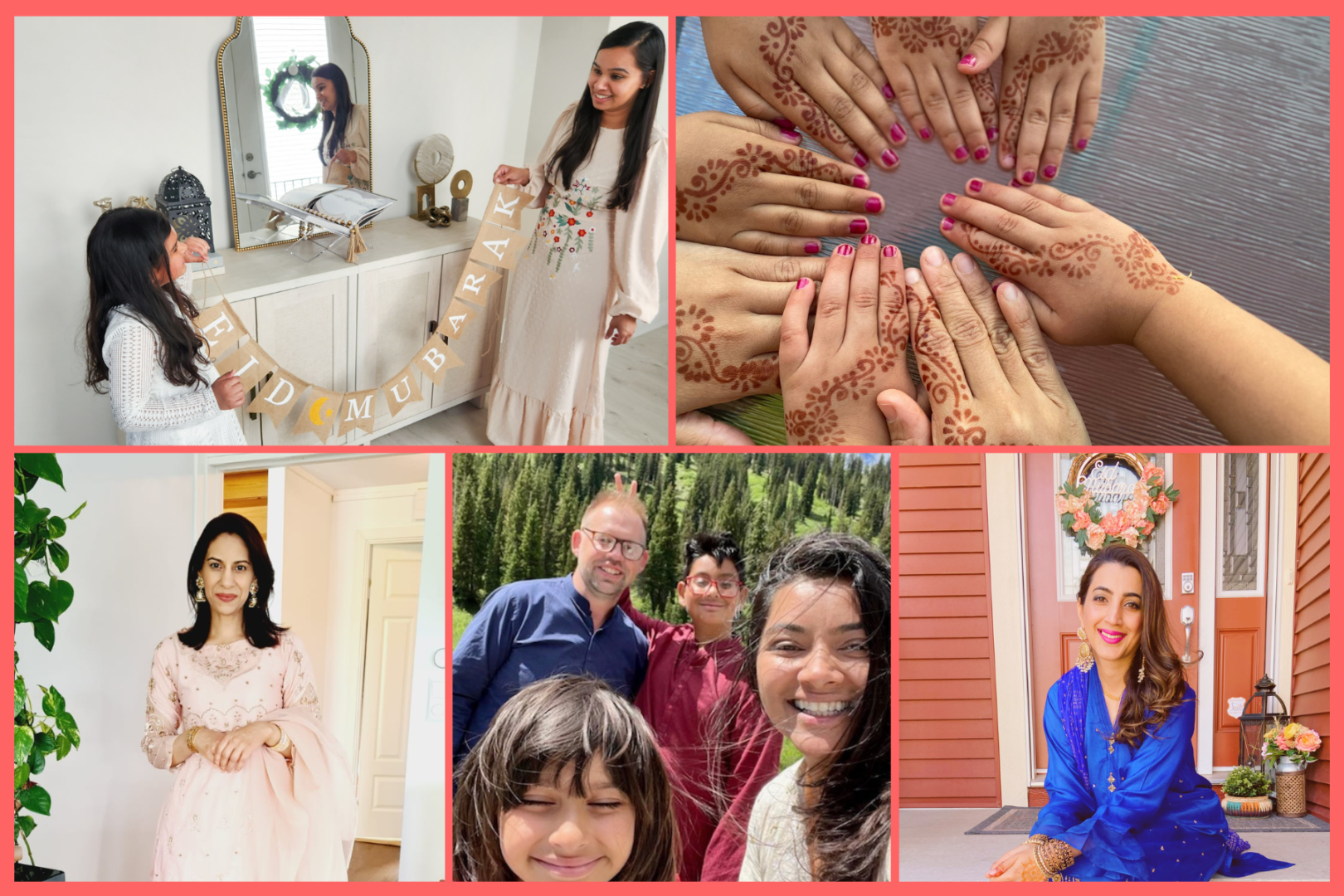
Eid-ul-Fitr is a special holiday that marks the end of Ramadan — the month of fasting — for Muslims worldwide. Ramadan is a time of gratitude, spiritual focus, forgiveness, celebrating community and helping the needy. Eid-ul-Fitr celebrations mark the conclusion of the holy month of Ramadan.
[Read Related: Tips and Resources to Teach Your Children About Ramadan]
This Ramadan, Brown Girl Magazine had the opportunity to connect with five popular immigrant moms and discuss how they make Eid celebrations meaningful and memorable for their children.
Rubab Bukhari
Rubab Bukhari is a busy mom of five based in Calgary, Canada. She shared that Eid, for her family, is a day of gathering with loved ones and sharing a delicious meal together as a symbol for breaking fast. “Eid is celebrated as the most joyous occasion where we put up Eid decorations and exchange gifts with everyone in the house. New clothes are made for everyone; the girls get excited about getting henna on their hands and the boys get more excited about receiving their Eidi (gifts/money).”
View this post on Instagram
While many family traditions are often passed down from generation to generation, these moms have added some newer customs to the Eid celebrations, giving the festival a personal touch.
Nazhah Khawaja
A published author, spoken word artist and dance fitness instructor, Nazhah Khawaja shares how she’s built new traditions with her two children and husband in Illinois, Chicago despite not being exposed to the “Eid flavor” herself while growing up.
“My sister suggested decorating the house for Eid with the goal of getting the kids in the holiday mood,” she said. Regardless of the exhaustion that followed due to decorating while fasting, Khawaja realized that her sister “was onto something.” She added that “kids are very visual learners and interpreters — the visual display of decorations helps them to feel the festivity more. Forever grateful to my sister for encouraging this tradition that our family has embraced.”
View this post on Instagram
Another new tradition that she has embraced is celebrating Eid festivities with her husband’s family who are non-Muslim. Furthermore, she insists on taking photographs during Eid-ul-Fitr to keep memories alive because one never really knows if the people in the photos will be there next time around. She also includes that the “Eid nap is a must — which means adults are dozing off while the kids are running wild; ample heavenly chaos and beautiful noise.”
Passing down familial customs from her mother, Khawaja remembers a story she had told her of how as soon as the dawn of Eid arrived, the villagers in Pakistan walked down unpaved streets welcoming Eid with a tune: “Mubarak Eid Mubarak/ Mubarak Khair Mubarak/ Saheliyon Eid Mubarak!” Khawaja’s mother used to sing it every time. “Growing up, my siblings and I would sing this tune in our not-so-refined Urdu, giggle at one another, create our own, often goofy lyrics, and even dance silly moves,” she shared.
Janan Sarwar
Meanwhile, Bengali shemai, Kashmiri kheer and ma’amoul are the favorite Eid desserts in Janan’s household! She is the founder and CEO of the publishing company, Global Bookshelves Intl., a pharmacist by profession and a mother of three young girls, based in Louisville, Kentucky. They look forward to dressing up their best for Eid prayers the most.
View this post on Instagram
“We love to create small gift bags for friends and to hand out to small children on Eid day,” Janan shared.
Ursula Sarah Khan
Likewise, Ursula Sarah Khan who is a mom influencer and an accountant by trade, said that they fill their Eid-themed gift bags with all sorts of goodies like candy, bubbles and pencils. On Eid-ul-Fitr, her eight-year-old son, Ibrahim, distributes these bags amongst the boys after Eid prayers, while her five-year-old daughter, Eliyah, hands them to the girls.
They also bake Eid cookies together in addition to swapping their Ramadan decor with Eid decor, while still in their Eid pajamas in their Northern Virginia home!
Blending older traditions with some newer ones, Sarah carries on her mother’s age-old tradition of making sheer khorma — a Pakistani dessert made with vermicelli, milk, dates and nuts — in the morning.
[Read Related:6 Muslim Content Creators Share Their Favorite Eid Recipes ]
She also explains to her children the importance of Zakat or charity, which is what her mother taught her: “I now take this same approach with my children to ensure they have a deep understanding of the generosity Islam teaches.”
View this post on Instagram
Haffsa Rizwani
Speaking of home and family, Haffsa Rizwani — a Canadian, currently residing in Stockholm, Sweden, as a PhD candidate — said: “Living away from home, Canada, where my immediate family resides, we have a tradition of traveling from Stockholm to my aunt’s house in Oslo, Norway, every Eid. Especially to mark the celebration as a family event for my children.” Together with her aunt, Haffsa’s daughter gets her henna done and goes shopping for bangles! She goes on to explain how Eid-ul-Fitr is an opportunity to not only dress up, but also regain that morning ritual of chai and evenings with games like carrom board; “a game played till my uncle wins.”
As Rizwani so eloquently puts it, “While my children are still quite small, my daughter is now of age to appreciate and understand the meaning of gratitude, blessings, and giving back. She now has the empathy to comprehend the inequalities and injustices in the world. Ramadan is therefore a month of being thankful and making extra duas. Eid is a day of celebration with gratitude and blessings.”
View this post on Instagram
What these moms wish for their children to learn from the spirit of Eid are the values of gratitude, generosity, compassion, togetherness and knowledge.




